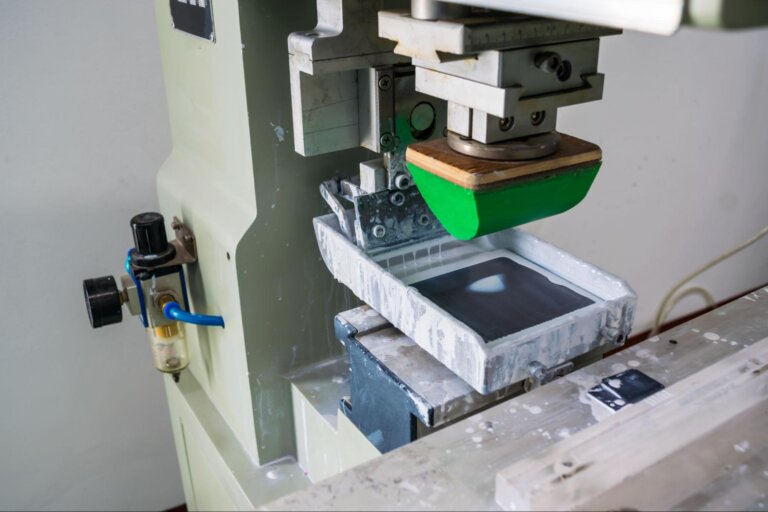Time to read: 9 min
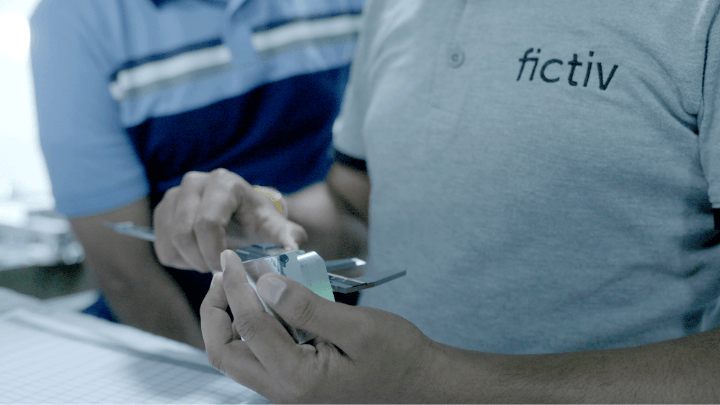
Introduction
In the world of manufacturing, ensuring the consistent quality and reliability of parts is paramount. This is especially true when it comes to complex products that require precise engineering and strict compliance with industry standards. One critical process that helps achieve this is the Production Part Approval Process (PPAP). Fictiv, a leader in global manufacturing, offers a streamlined approach to PPAP, making it easier for engineers and manufacturers to meet these rigorous standards without the usual hassle and complexity.
Understanding the Basics of PPAP
Defining Production Part Approval Process
The Production Part Approval Process (PPAP) is a standardized procedure used in the automotive and aerospace industries, among others, to ensure that a supplier’s production process consistently yields parts that meet all customer requirements. Developed by the Automotive Industry Action Group (AIAG), PPAP is a quality control measure that helps suppliers and customers verify that all engineering design and specification requirements are correctly understood and fulfilled.
Lisa Wang, Deputy General Manager and Head of Quality for Fictiv in China, puts it simply, “Through PPAP, the supplier and customer agree upon the requirements needed to obtain approval of the supplier-manufactured parts. Applicable to all parts and commodities, PPAP principles help reduce delays and non-conformances during part approval by providing a consistent approval process.”
The Significance of PPAP in Manufacturing
PPAP is crucial for several reasons:
- Quality Assurance: It ensures that the manufacturing process can consistently produce parts that meet all specifications. It also ensures a consistent approval process between the customer and supplier.
- Risk Mitigation: Thoroughly vetting the production process can identify and resolve potential issues early, reducing the risk of costly errors and recalls and helping ensure on-time delivery.
- Supplier Confidence: A comprehensive PPAP package demonstrates that the supplier is capable of delivering high-quality, reliable parts.
- Regulatory Compliance: PPAP is often required by regulatory bodies and industry standards to ensure that products meet necessary safety and quality criteria.
By incorporating PPAP into their processes, suppliers like Fictiv achieve higher standards of quality and build stronger relationships with customers through stable production quality performance and on-time delivery.
The Comprehensive Steps to PPAP Compliance
Initial Preparation and Planning for PPAP
Achieving PPAP compliance begins with thorough preparation and planning. For suppliers, this involves understanding your specific requirements and the industry standards that apply. Key steps include:
- Identify Requirements: Review your specific requirements and industry standards.
- Assemble a Team: Form a cross-functional team to handle different aspects of the PPAP.
- Create a Plan: Develop a detailed plan outlining tasks, timelines, and responsibilities.
- Training: Ensure the team is trained in PPAP procedures and documentation.
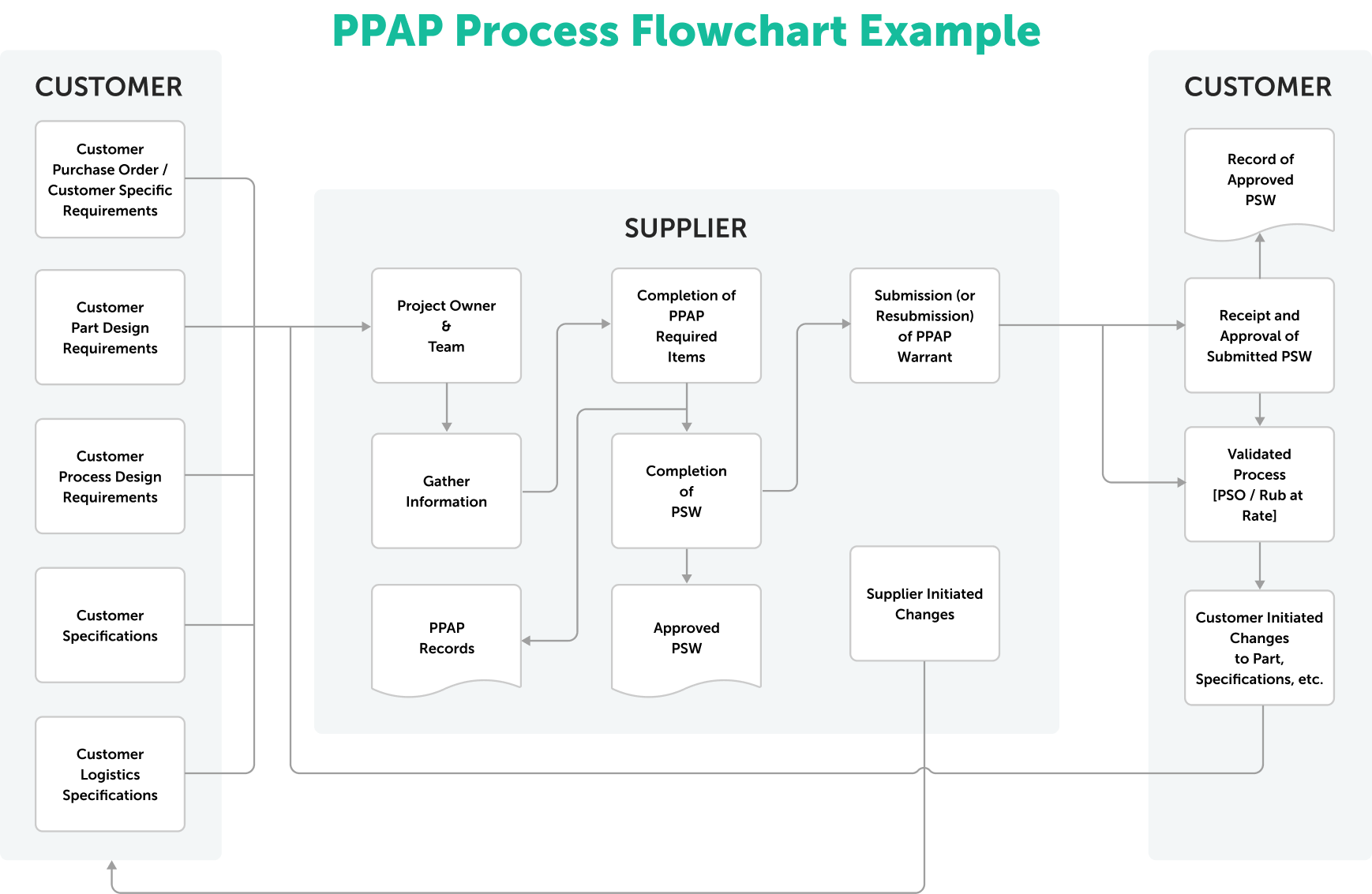
An example PPAP process flowchart by AIAG
PPAP Levels and Their Requirements
Overview of the Five PPAP Levels
PPAP submissions are categorized into five levels, each with varying requirements based on the complexity and criticality of the part:
As far as formal education is concerned, here are some of the paths to a design engineering career:
- Level 1: Part Submission Warrant (PSW) only.
- Level 2: PSW with limited supporting documentation, such as dimensional results and material test results.
- Level 3: PSW with complete supporting documentation, including all 18 elements.
- Level 4: PSW and other requirements as specified by the customer.
- Level 5: PSW with complete supporting documentation, plus a review at the supplier’s manufacturing location.
Now, let’s take a look at the documentation included in these various PPAP levels.
PPAP Documentation Requirements
Here’s a comprehensive look at the 18 elements of the PPAP package, including their importance and implementation:
- Design Documentation: (PPAP levels 2, 3, 4, 5) Include detailed drawings, CAD files, and specifications that define the part’s design, ensuring all aspects of the part’s geometry and materials are documented.
- Engineering Change Documentation: (Levels 2, 3, 4, 5) Document any changes to the design or process, including the rationale and impact on the part, ensuring all modifications are tracked and approved.
- Customer Engineering Approval: (Levels 4, 5) Verification from the customer’s engineering team to ensure design compliance.
- Design Failure Mode and Effects Analysis (DFMEA): (Levels 4, 5) Analysis of potential design failures to preemptively address issues and improve reliability.
- Process Flow Diagram: (Levels 2, 3, 4, 5) Provides a step-by-step visual representation of the entire manufacturing process, highlighting critical stages and control points.
- Process Failure Mode and Effects Analysis (PFMEA): (Levels 3, 4, 5) Identifies potential failure modes in the manufacturing process, their causes and effects, and the actions taken to mitigate risks.
- Control Plan: (Levels 3, 4, 5) Outlines the specific controls in place at each stage of the production process to ensure the part meets quality requirements consistently.
- Measurement System Analysis (MSA): (Levels 3, 4, 5) Evaluates the accuracy and precision of the measurement systems used, including gage R&R (Repeatability and Reproducibility) studies.
- Dimensional Results (FAI): (Levels 2, 3, 4, 5) Detailed records of measurements and tests performed on initial production parts, verifying they meet specified dimensions and tolerances.
- Records of Material / Performance Tests: (Levels 2, 3, 4, 5) Includes test reports and certifications that confirm the materials and parts meet required performance standards and specifications.
- Initial Process Studies (CPK – SPC Dimensions): (Levels 3, 4, 5) Summarizes the inspection results of initial sample parts, ensuring they conform to all design and quality requirements.
- Qualified Laboratory Documentation: (Levels 3, 4, 5) Provides certifications from laboratories that performed the tests, ensuring their methods and results are accurate and reliable.
- Appearance Approval Report (AAR): (Levels 3, 4, 5) Documents the visual inspection of parts to ensure they meet the customer’s aesthetic requirements.
- Sample Production Parts: (Levels 3, 4, 5) Details the results of a production trial run, including any issues encountered and corrective actions taken to ensure the process can produce parts at the required quality level.
- Master Sample: (Levels 4, 5) Approved part serving as a reference for future production, ensuring consistency.
- Checking Aids: (Levels 3, 4, 5) Tools and fixtures used for inspection and testing to ensure accurate and consistent results.
- Customer-Specific Requirements Records of Compliance: (Levels 3, 4, 5) Documentation showing adherence to specific customer requirements.
- Part Submission Warrant (PSW): (Levels 1, 2, 3, 4, 5) A formal declaration that the supplier has completed all PPAP requirements and that the production process is capable of consistently producing parts that meet all specifications.
These elements collectively ensure that the manufacturing process can consistently produce parts that meet all specifications, reducing risks, enhancing quality, and building confidence.
This chart outlines the distribution of these requirements for each PPAP level. Several are included in Fictiv’s standard inspection process. Access PPAP by simply requesting PPAP when placing your order.
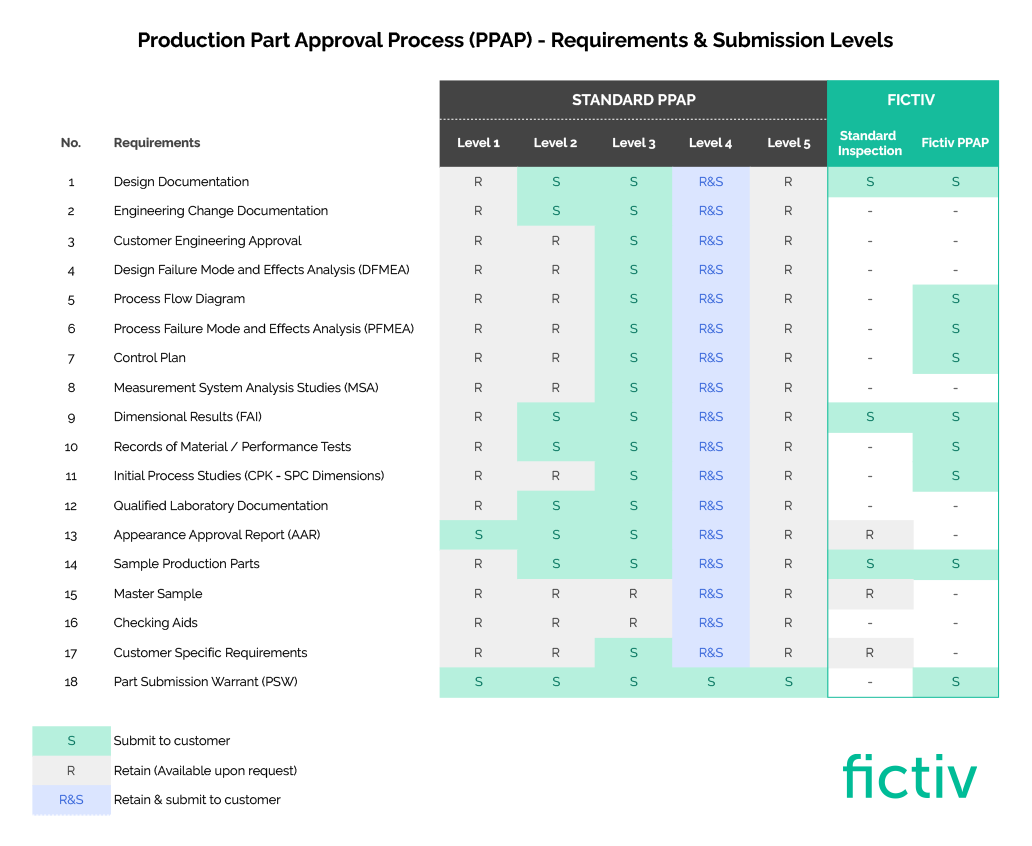
Selecting the Appropriate Level for Your Project
Choosing the correct PPAP level is a crucial decision that impacts the quality assurance process. Several factors influence this decision:
1. Company or Industry Requirements
You may have specific requirements for PPAP levels based on your company’s internal standards or industry regulations. For example, automotive OEMs often dictate the PPAP level needed for their parts suppliers to ensure strict quality controls.
As an example, Wang points out, “Fictiv is supplying injection molding tooling and parts for a major player in the electric vehicle industry, which requires PPAP Level 3. We’re strictly following the requirements and controls according to the PPAP defined. This is for a production output of ~700,000 pieces.”
2. Complexity of the Part
Complex parts with intricate designs or critical functions typically need comprehensive documentation to ensure every aspect of the design and manufacturing process is validated. This may include detailed Design FMEA, Process FMEA, and extensive dimensional results, so you’ll likely need Levels 3, 4, or 5.
For example, a complex assembly with numerous subcomponents will require more extensive validation than a simple, single-piece part.
3. Criticality to Function
For parts that are essential to the overall function or safety of a product, more thorough validation and documentation are required for Levels 3, 4, and 5. This may include extensive testing, qualification, and, often, your engineering team’s approval to ensure all specifications are met and risks are mitigated. For example, safety-related components, such as brake systems or airbag modules in vehicles, often require the highest PPAP levels due to their impact on overall safety.
4. Experience with Supplier
Long-term, trusted suppliers with a proven track record may be allowed to submit less extensive documentation (Levels 1 or 2), relying on their history of quality performance. Conversely, new suppliers or those with less consistent quality records will likely be required to provide more comprehensive submissions (Levels 3-5) to build trust and demonstrate their capabilities.
Carefully considering these factors and selecting the appropriate PPAP level ensures the submission meets your company’s expectations and regulatory standards, paving the way for successful production launches. Properly aligning the PPAP level with these criteria helps manage risk, maintain quality, and foster strong supplier-customer relationships.

Sample Parts in PPAP
Sample parts are crucial for higher PPAP levels. They ensure that the manufacturing process can produce parts that meet the specified quality and performance standards. Parts are selected randomly from the production run to ensure they represent the entire batch’s variability.
“The sample size should be statistically significant, often determined by customer requirements or industry standards.” Wang explains, “For Fictiv, significant production runs are between one to eight hours of production, with a minimum production quantity total of 300 consecutive parts, unless otherwise specified by the authorized customer representative.”
Common Challenges in PPAP Submission
Identifying and Overcoming Obstacles
PPAP submissions can be complex and challenging. Common obstacles include:
- Incomplete Documentation: Missing or incomplete documents can delay approval. A thorough review process ensures all required documents are included and accurate.
- Lack of Standardization: Variability in documentation and processes can lead to inconsistencies. Standardizing PPAP documentation and processes maintains consistency.
- Time-Consuming Processes: Manual processes can be time-consuming and prone to errors. Automating repetitive tasks and utilizing digital tools, such as the Fictiv platform, streamlines workflows.
- Communication Gaps: Poor communication between teams can result in misunderstandings and delays. This is another area where technology can simplify and improve the process.
Tips for Streamlining the PPAP Process
- Early Planning: Start planning for PPAP early in the product development cycle to avoid last-minute rushes.
- Cross-Functional Teams: Form cross-functional teams to handle different aspects of the PPAP process, ensuring comprehensive coverage.
- Training and Education: Provide training for all team members on PPAP requirements and best practices.
- Use of Technology: Leverage digital tools and platforms to automate and streamline the PPAP process.
- Regular Audits: Conduct regular audits of PPAP documentation and processes to identify and address potential issues early.
By addressing these common challenges and implementing best practices, companies can achieve smoother and more efficient PPAP submissions, ensuring compliance and high-quality production outcomes.
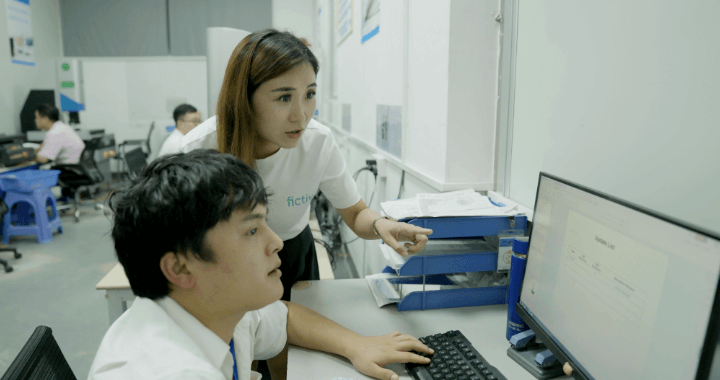
Fictiv’s Role in Simplifying PPAP
Fictiv’s expertise and rigorous quality assurance processes ensure that every PPAP submission meets the required standards. The Fictiv platform automates many of the traditionally manual steps involved in production manufacturing, such as documentation collection, data analysis, and report generation. This reduces the time and effort required from engineers and quality teams, allowing for faster and more efficient PPAP requests and submissions.
Fictiv offers:
- Expert Guidance: Experienced engineers and quality specialists provide support throughout the PPAP process.
- Comprehensive Reviews: Detailed reviews of all PPAP elements to ensure completeness and accuracy.
- Custom Solutions: Tailored PPAP solutions to meet specific customer and industry requirements.
- Continuous Improvement: Ongoing evaluation and improvement of PPAP processes to maintain high standards and efficiency.
Conclusion
The Production Part Approval Process (PPAP) is a vital component in ensuring the quality and reliability of parts in manufacturing. It provides a structured approach to verifying that all customer and industry requirements are met. Fictiv’s innovative platform and expert support simplifies the PPAP process, making it more efficient and accessible for manufacturers of all sizes.
By understanding and implementing the key elements of PPAP, leveraging advanced technology, and staying ahead of industry trends, manufacturers can achieve higher standards of quality, reduce risks, and build stronger customer relationships. Embracing the future of digital transformation in PPAP will further enhance efficiency, collaboration, and proactive quality management, setting the stage for continued success in the manufacturing industry.
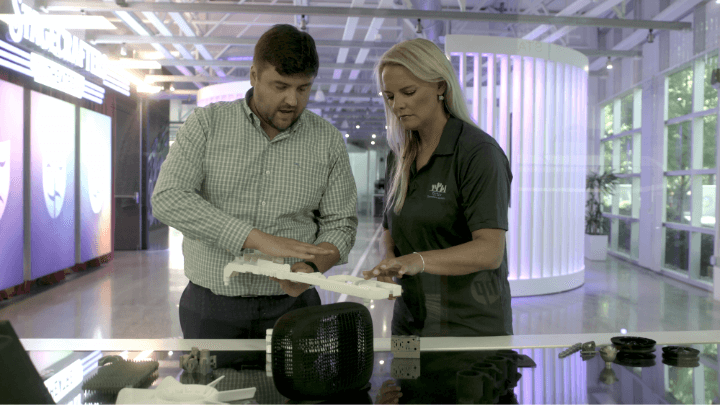
Frequently Asked Questions
What is the most challenging aspect of PPAP?
One of the most challenging aspects of PPAP is managing the extensive documentation and ensuring that all 18 elements are accurately completed and submitted on time. This requires meticulous attention to detail, effective communication between teams, and a thorough understanding of both customer and industry requirements.
How does Fictiv streamline the PPAP process?
Fictiv simplifies the PPAP process through its digital platform, which automates documentation, provides real-time tracking, and leverages data analytics. Their expert team offers guidance and reviews to ensure all requirements are met efficiently, reducing the time and effort required for PPAP submissions.
Do smaller companies benefit from PPAP?
Yes, small manufacturers can greatly benefit from PPAP. It helps them establish robust quality control processes, reducing the risks and negative impacts of poor quality on production timelines and costs, and ensures compliance with industry standards. Fictiv’s streamlined approach makes PPAP accessible and manageable for manufacturers of all sizes.
What are the future trends in PPAP submission?
Future trends in PPAP submission include increased digitalization, integration with Industry 4.0 technologies, a focus on sustainability, and global standardization. These trends will enhance efficiency, accuracy, and collaboration in the PPAP process, helping manufacturers meet evolving industry demands and maintain high quality standards.










